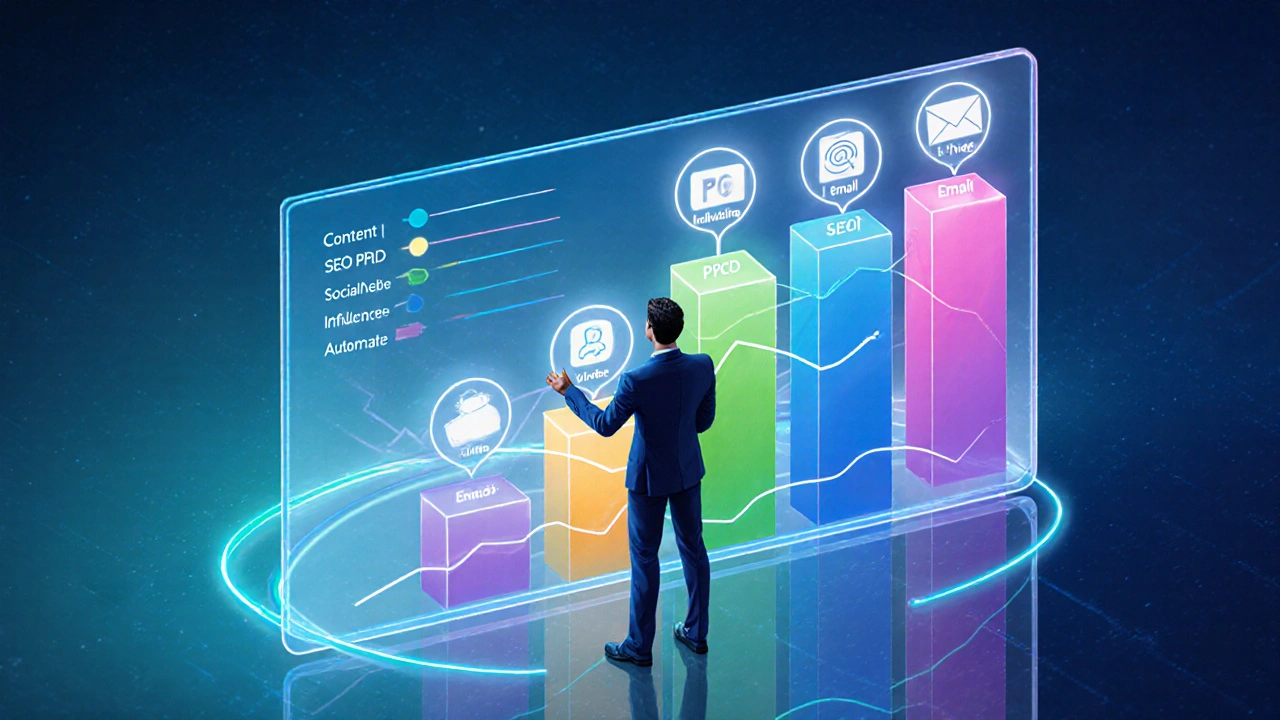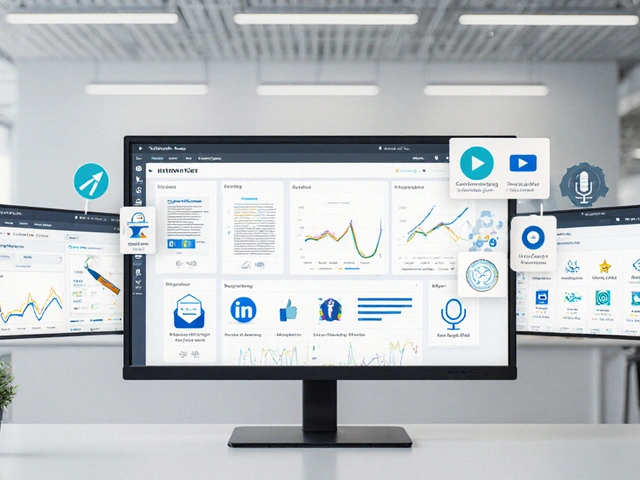Digital Marketing Strategy Calculator
Find Your Best Marketing Channels
Answer a few questions to discover which digital marketing strategies will work best for your business.
Recommended Marketing Channels
Channel Comparison
Content Marketing: 3,000%+
SEO: 2,500%+
PPC: 400%-1,200%
Email: 3,800%+
Content Marketing: $2,000-$5,000
SEO: $1,500-$4,000
PPC: $1,000-$3,000/month
Email: $500-$2,000
Content Marketing: 3-6 months
SEO: 4-9 months
PPC: Days
Email: Weeks
When businesses talk about Digital Marketing Strategies coordinated plans that blend online channels to attract, engage, and convert customers, they need a clear roadmap that works across budgets and goals. This guide walks you through the core tactics, shows how to combine them, and highlights common traps that can waste time and money.
1. Content Marketing: The Foundation
First up, Content Marketing the practice of creating and distributing valuable, relevant, and consistent content to attract a clearly defined audience. It fuels SEO, nurtures leads, and establishes authority. A practical start is mapping buyer personas to content types-blog posts for awareness, whitepapers for consideration, and case studies for decision stages. Real‑world example: a Brisbane-based home‑renovation firm saw a 42% lift in organic leads after publishing a weekly “DIY tips” blog and promoting it via email.
- Identify core topics that solve customer problems.
- Set a publishing cadence (e.g., two posts per week).
- Repurpose content into videos, infographics, and slide decks.
2. Search Engine Optimization (SEO)
Next is Search Engine Optimization the set of techniques that improve a website’s visibility in organic search results. SEO begins with keyword research-use tools like Ahrefs or Google Keyword Planner to find terms with commercial intent and reasonable difficulty. On‑page basics include meta titles, header tags, and internal linking. Technical health (mobile‑first, page speed, schema markup) is non‑negotiable; a 1‑second delay can cut conversions by 7%.
- Audit your site for crawl errors and broken links.
- Optimize each page for a primary keyword and related LSI terms.
- Earn backlinks through guest posts, partnerships, and data‑driven assets.
3. Pay‑Per‑Click Advertising (PPC)
When you need quick traffic, Pay‑Per‑Click Advertising a paid model where advertisers pay each time a user clicks on their ad delivers immediate results. Google Ads dominates search‑intent bids, while platforms like Microsoft Advertising capture a niche professional audience. Start with a tightly scoped campaign: select high‑intent keywords, write compelling ad copy, and land on a dedicated, conversion‑optimized landing page.
- Set a daily budget based on cost‑per‑acquisition targets.
- Use ad extensions (sitelinks, callouts) to boost click‑through rates.
- Implement conversion tracking to refine bidding strategies.
4. Email Marketing: Direct Relationship
Email Marketing sending targeted messages to a list of subscribers to nurture leads and drive sales remains one of the highest‑ROI channels-often surpassing 3,800%. Effective email programs segment audiences (new leads, active customers, lapsed buyers) and tailor content accordingly. Automation tools let you trigger welcome series, cart abandonment reminders, and re‑engagement campaigns without manual effort.
- Clean your list regularly to maintain deliverability.
- Craft subject lines under 50 characters for mobile readability.
- Test send times and copy with A/B experiments.

5. Social Media Marketing
For brand awareness and community building, Social Media Marketing the use of platforms like Facebook, Instagram, LinkedIn, and TikTok to share content and engage audiences is essential. Choose platforms that align with your buyer personas-B2B firms lean on LinkedIn, while lifestyle brands thrive on Instagram and TikTok. Consistency matters; a content calendar helps maintain a steady flow of posts, stories, and live sessions.
- Leverage native features (reels, stories, polls) for higher organic reach.
- Invest in paid social for precise demographic targeting.
- Monitor engagement metrics (comments, shares) to refine tone.
6. Influencer & Video Marketing
Building trust quickly can be achieved through Influencer Marketing partnering with individuals who have sway over a target audience to promote products or services and Video Marketing creating video content to convey brand messages, demonstrate products, or educate viewers. Short‑form videos (under 60 seconds) perform well on TikTok and Instagram Reels, while longer tutorials thrive on YouTube.
- Identify micro‑influencers (5k‑50k followers) for niche credibility.
- Develop a brief that aligns brand values with creator style.
- Track performance via UTM parameters and view‑through conversions.
7. Marketing Automation: Scaling Your Efforts
As your mix expands, Marketing Automation software that automates repetitive tasks like email nurturing, lead scoring, and social posting becomes the glue that holds everything together. Platforms such as HubSpot, Marketo, or the more affordable ActiveCampaign let you build workflows that trigger actions based on behavior (e.g., download a guide → add to lead nurture stream).
- Map the customer journey and assign triggers at each stage.
- Use dynamic content to personalize web experiences.
- Regularly audit automation rules to avoid “ghost” leads.

8. Choosing the Right Mix: Decision Framework
Not every tactic fits every business. Below is a quick comparison that helps you prioritize based on budget, timeline, and impact.
| Channel | Average ROI (annual) | Initial Budget (USD) | Time to First Result |
|---|---|---|---|
| Content Marketing | 3,000%+ | 2,000‑5,000 | 3‑6 months |
| SEO | 2,500%+ | 1,500‑4,000 | 4‑9 months |
| PPC | 400%‑1,200% | 1,000‑3,000 (monthly) | Days |
| 3,800%+ | 500‑2,000 | Weeks | |
| Social Media | 1,200%‑3,000% | 1,000‑3,000 | 1‑3 months |
| Influencer/Video | 800%‑2,500% | 2,000‑10,000 | Weeks |
| Automation | Varies (efficiency gain) | 1,000‑5,000 | 1‑2 months |
Start with a core set-content, SEO, and email-then layer in paid and social tactics as resources allow. Measure, iterate, and let data dictate where you double‑down.
9. Common Pitfalls & Pro Tips
Even seasoned marketers stumble. Here are three avoidable mistakes and how to fix them:
- Spreading too thin. Focus on 2‑3 channels first; mastery beats mediocrity.
- Ignoring data. Set up dashboards in Google Data Studio or Power BI to track CAC, LTV, and channel attribution weekly.
- Neglecting mobile. Ensure every landing page loads under 3 seconds and uses responsive design.
Remember, the goal isn’t to use every tactic, but to build a cohesive ecosystem that moves prospects from awareness to advocacy.
Key Takeaway
Mastering digital marketing strategies means picking the right mix, executing with consistency, and letting analytics steer your next move. The sooner you align tactics with customer intent, the faster you’ll see sustainable growth.
What is the first step to building a digital marketing plan?
Start by defining clear business objectives and mapping them to specific audience personas. This creates a foundation for selecting the right channels and measuring success.
How long does SEO usually take to show results?
Most businesses see noticeable organic traffic gains within 4‑9 months, depending on competition, content quality, and technical health of the site.
Can a small business succeed with only organic strategies?
Yes, if the niche isn’t overly saturated. A disciplined content marketing and SEO approach can generate sustainable leads without a large ad spend.
What budget should I allocate to PPC for a starter campaign?
Begin with a test budget of $1,000‑$2,000 per month, focusing on high‑intent keywords. Analyze cost‑per‑click and conversion data before scaling.
How often should I update my content calendar?
Review the calendar quarterly. Adjust topics based on keyword trends, seasonal events, and performance metrics from the previous period.




Write a comment